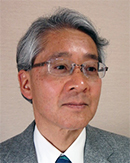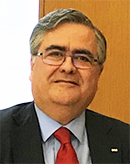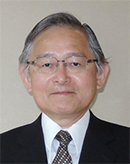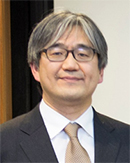The Fourth ISAS Award (FY 2017)
The Fourth ISAS Award was given to the following four individuals in March 2018, including special prizes honoring two individuals for their long years of service. We at JAXA ISAS would like to express our deepest gratitude for the cooperation and support we receive from these external organizations and will continue to work toward further external collaboration.
| Recipient (honorifics omitted) | Reason for award |
|---|---|
| Tsugunobu Nagai | [Special Award] for Elucidation of Physical Processes in “Magnetic Reconnection” Driving Dynamics in Magnetotail |
| Álvaro Giménez | [Special Award] for Exceptional Contributions to Euro-Japan Partnership in Space Science and Exploration |
| Akiyoshi Sato | For Establishment of an Ultrasonic Flaw Detection Method for Quality Assurance of Solid Rocket Motors |
| Ryohei Kano | For Proof-of-principle of a New Method for Acquiring Magnetic Field Information in the Chromosphere and Corona Due to the Hanle Effect |
Recipient Profiles
Tsugunobu Nagai
Professor
Earth and Planetary Science Program
Faculty of Science
Tokyo Institute of Technology

Special Award in Recognition of
Elucidation of Physical Processes in “Magnetic Reconnection” Driving Dynamics in Magnetotail
Professor Tsugunobu Nagai’s research focuses on near-Earth space (the magnetosphere), a field in which he has received high international acclaim. In particular, through his comprehensive analysis of data obtained over many years by the GEOTAIL satellite (launched in 1992, still in operation), he has elucidated the physical processes behind a phenomenon known as “magnetic reconnection” that drives the dynamics of the magnetotail. In addition, the new research methods he introduced in those studies have modernized observational research of magnetic reconnection. For these many years of accomplishments, we award him a Special ISAS Award.
Earth has an intrinsic magnetic field that floats in the space of the solar system. A stream of ionized gas (plasma) called the solar wind blows from the center of our solar system and collides with Earth’s magnetic field to form the magnetosphere. In the magnetospheric tail located on the night side of Earth, magnetic current lines stretch out into a sheet-like current layer. The auroras that light up the polar regions have been observed to sharply brighten and shine across the entire sky. Magnetic reconnection in the current layer of the magnetospheric tail plays an important role in this phenomenon.
The GEOTAIL satellite has an orbit and observation equipment suitable for elucidating the physics of magnetic reconnection. Professor Nagai has accumulated observations accumulated over many years, which he carefully analyzed using new methodologies, thereby deriving results for which he has received high international acclaim. These results have had a significant impact on the US and European missions following GEOTAIL.
Tsugunobu Nagai
Graduated 1977, M.S. Astronomy, University of Tokyo. Positions at the Kakioka Magnetic Observatory, NASA Marshall Space Flight Center, Meteorological Research Institute, and Tokyo Institute of Technology since 1993. AGU Fellow. At the Meteorological Research Institute, he developed simulations of the El Niño phenomenon using a coupled atmosphere–ocean model. He continues his research at the Tokyo Institute of Technology, using the ISAS satellites GEOTAIL and Akebono.
Álvaro Giménez
Former Science Director
European Space Agency (ESA)

Special Award in Recognition of
Exceptional Contributions to Euro-Japan Partnerships in Space Science and Exploration
Álvaro Giménez made outstanding contributions to cooperative space-science missions between JAXA/ISAS and ESA during his tenures as ESA Director of Science and Robotic Exploration from April 2011 and ESA Science Director since January 2016.
He has wide-ranging contributions, including development of the European space science community and the JAXA/ESA joint missions that it supports. Some notable examples include the following:
- Dr. Giménez led the complex BepiColombo mission, a JAXA/ESA joint mission to Mercury, taking a central role in major developmental issues and launch schedule reviews. Thanks to his leadership, the BepiColombo satellites were successfully launched in October 2018.
- In the X-ray astronomical satellite ASTRO-H project, he took a central role supporting ESA’s provision of equipment and participation by European scientists. He led European scientists after the cessation of ASTRO-H operations, and through his understanding of the significance of X-ray astronomy observations, his support for an alternative X-ray astronomy spacecraft, and his efforts to obtain agreement for ESA participation, Dr. Giménez contributed greatly to the establishment of the replacement X-ray observation satellite mission (XARM).
- The infrared space telescope SPICA is a large, complex mission based on proposals from the scientific communities of Japan and Europe, and Giménez dramatically increased the feasibility of this mission by promoting system reviews at JAXA and ESA.
Akiyoshi Sato
Lead Technician
Quality Assurance Division
IHI Aerospace Co., Ltd.

Award in Recognition of
Establishment of an Ultrasonic Flaw Detection Method for Quality Assurance of Solid Rocket Motors
ISAS has worked with IHI Aerospace to revamp quality assurance methods for the upper-stage motor of the Epsilon rocket.
Solid-propellant motors cannot be tested in actual rockets, so quality assurance has conventionally been carried out by radiation flaw detection testing (X-ray flaw detection). It can become impossible to maintain the X-ray generator (linac) for the upper-stage motor due to aging or discontinuation by the manufacturer. Akiyoshi Sato developed an ultrasonic flaw detection method that does not require large equipment or buildings. With this method, inspections can be completed in a short time.
In November 2015, we used this new ultrasonic flaw detection method to perform quality assurance inspections on the third-stage motor aboard flight 2 of the Epsilon rocket. This contributed to significant cost reductions while maintaining Epsilon rocket reliability, and it was mentioned as a research highlight in the FY2015 ISAS project evaluation. Flight 2 of the Epsilon rocket successfully launched in December 2016.
After that, he established a new quality assurance method for the enhanced Epsilon rocket two-stage motor, and he is currently developing quality assurance methods for the SRB-3 motor (an Epsilon single-stage motor in synergy with the H3 rocket). ISAS and IHI Aerospace’s quality assurance department performed coordinated R&D for these projects, which Mr. Sato has greatly advanced as chief engineer.
Akiyoshi Sato
The Aerospace Division of Nissan Motor Co., Ltd. has worked for many years developing non-destructive inspection technologies for the aerospace field. This division was moved to IHI Aerospace Co., Ltd. upon its founding in 2000, and Akiyoshi Sato has been working there since 2008. He is engaged in the development of nondestructive evaluation technologies for graphite, solid propellant, and composite laminate-structure rocket parts. His recent research aims at practical application of displacement measurements of large space structures by an optical method (the sampling Moire method).
Ryohei Kano
Associate Professor
SOLAR-C Project Office
National Astronomical Observatory of Japan

Award in Recognition of
A Proof-of-principle of a New Method for Acquiring Magnetic Field Information in the Chromosphere and Corona Due to the Hanle Effect
The Chromospheric Lyman-Alpha SpectroPolarimeter (CLASP) project used a NASA sounding rocket to make high-precision (approx. 0.1%) measurements of the linear polarization of Lyman-α rays (122 nm) emitted from the solar upper chromosphere and transition layer. The aim of this was to demonstrate the principle of a new method for obtaining coronal magnetic field information from the chromosphere that cannot be acquired using the Zeeman effect method that is generally applied to magnetic field measurements of the photosphere. Five countries—Japan, the U.S., Spain, France, and Norway—conducted joint research for the CLASP experiment, with Professor Ryohei Kano serving as principal investigator for the Japan team. The launch was in September 2015. The observation device worked perfectly and to great success, achieving the originally planned 0.1% polarization accuracy.
Analysis of the polarization profile of Lyman-α rays provided world-first confirmation of the quantum mechanical Hanle effect, opening the way for future measurements of atomic polarization in vacuum ultraviolet light and magnetic fields, and moving us toward the dream in the solar observation field of obtaining magnetic field information from across the entire solar atmosphere. Indeed, NASA has approved a second mission (CLASP2) for launch in 2019, with the aim of acquiring a new ultraviolet spectrum (Mg II, 280 nm) to establish measurement methods for magnetic fields in the chromosphere and above.
There are no ready-made products for any of the required polarizing elements, and developing these devices is extremely difficult. Serving as principal investigator, Professor Kano made remarkable contributions toward the development of mission equipment overall, led young researchers and students, and produced significant academic results through his leadership in development of these technologies.
Ryohei Kano
After serving as a part-time researcher at the National Astronomical Observatory of Japan, Research Fellow at the Japan Society for the Promotion of Science, and assistant at the National Astronomical Observatory, Ryohei Kano took his current position in 2015. Following the launch of Japan’s Yohkoh satellite, he became engaged in research of the solar corona using a soft X-ray telescope along with operation of that telescope.
He later led design and development of optical systems and cameras for ISAS’s XUV Doppler Telescope (S520 CN-22 sounding rocket) sounding rocket experiment and the Hinode X-ray telescope. In 2015 he was the Japan-side principle investigator for the Japan–U.S.–Europe CLASP experiment using NASA sounding rockets, where he helped to develop observation equipment and to produce scientific achievements.
